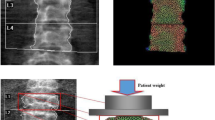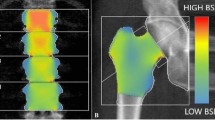Abstract
Summary
A new qualitative index of bone strength, based on finite element analysis and named bone strain index, has been recently developed from lumbar DXA scan. This study shows that BSI predicts subsequent re-fracture in osteoporotic patients affected by fragility fractures.
Introduction
Dual-energy X-ray absorptiometry (DXA) can provide quantitative (bone mineral density, BMD) and qualitative (trabecular bone score, TBS) indexes of bone status, able to predict fragility fractures in most osteoporotic patients. A new qualitative index of bone strength, based on finite element analysis and named bone strain index (BSI), has been recently developed from lumbar DXA scan. This study presents the validation results of BSI prediction for re-fracture in osteoporotic patients with fragility fractures.
Methods
In three academic hospitals, 234 consecutive fractured patients with primary osteoporosis (209 females) performed a spine X-ray for the calculation of spine deformity index (SDI) and DXA densitometry for BMD, TBS and BSI at the basal time and in the follow-up at each clinical check. A subsequent fracture was considered as one unity increase of SDI.
Results
For each unit increase of the investigated indexes, the univariate hazard ratio of re-fracture, 95% CI, p value and proportionality test p value are for age 1.040, 1.017–1.064, 0.0007 and 0.2529, respectively, and for BSI 1.372, 1.038–1.813, 0.0261 and 0.5179, respectively. BSI remained in the final multivariate model as a statistically significant independent predictor of a subsequent re-fracture (1.332, 1.013–1.752 and 0.0399) together with age (1.039, 1.016–1.064 and 0.0009); for this multivariate model proportionality test, p value is 0.4604.
Conclusions
BSI appears to be a valid DXA index of prediction of re-fracture, and it can be used for a more refined risk assessment of osteoporotic patients.


Similar content being viewed by others
Data availability
All data are available on request to the corresponding author.
References
(1993) Consensus development conference: diagnosis, prophylaxis, and treatment of osteoporosis. In: Am J Med. pp 646–650
Kanis JA, Cooper C, Rizzoli R, Reginster JY (2019) European guidance for the diagnosis and management of osteoporosis in postmenopausal women. Osteoporos Int 30:3–44. https://doi.org/10.1007/s00198-018-4704-5
Kanis JA (2007) Assessment of osteoporosis at the primary health care level. World Health 339
Lindsay R, Silverman SL, Cooper C, Hanley DA, Barton I, Broy SB, Licata A, Benhamou L, Geusens P, Flowers K, Stracke H, Seeman E (2001) Risk of new vertebral fracture in the year following a fracture. J Am Med Assoc 285:320–323. https://doi.org/10.1001/jama.285.3.320
(1994) Assessment of fracture risk and its application to screening for postmenopausal osteoporosis. Report of a WHO Study Group. World Health Organ Tech Rep Ser 843:1–129
Marshall D, Johnell O, Wedel H et al (1996) Meta-analysis of how well measures of bone mineral density predict occurrence of osteoporotic fractures. BMJ 312:1254–1259. https://doi.org/10.1136/bmj.312.7041.1254
Siris ES, Chen Y-T, Abbott TA, Barrett-Connor E, Miller PD, Wehren LE, Berger ML (2004) Bone mineral density thresholds for pharmacological intervention to prevent fractures. Arch Intern Med 164:1108–1112. https://doi.org/10.1001/archinte.164.10.1108
Seeman E, Delmas PD (2006) Bone quality - the material and structural basis of bone strength and fragility. N Engl J Med 354:2250–2261
Krohn K, Schwartz EN, Chung YS, Lewiecki EM (2019) Dual-energy X-ray absorptiometry monitoring with trabecular bone score: 2019 ISCD Official Position. J Clin Densitom 22:501–505
Hans D, Barthe N, Boutroy S, Pothuaud L, Winzenrieth R, Krieg MA (2011) Correlations between trabecular bone score, measured using anteroposterior dual-energy X-ray absorptiometry acquisition, and 3-dimensional parameters of bone microarchitecture: an experimental study on human cadaver vertebrae. J Clin Densitom 14:302–312. https://doi.org/10.1016/j.jocd.2011.05.005
Hans D, Goertzen AL, Krieg M-A, Leslie WD (2011) Bone microarchitecture assessed by TBS predicts osteoporotic fractures independent of bone density: the Manitoba study. J Bone Miner Res 26:2762–2769. https://doi.org/10.1002/jbmr.499
Pothuaud L, Barthe N, Krieg M-A, Mehsen N, Carceller P, Hans D (2009) Evaluation of the potential use of trabecular bone score to complement bone mineral density in the diagnosis of osteoporosis: a preliminary spine BMD-matched, case-control study. J Clin Densitom 12:170–176. https://doi.org/10.1016/j.jocd.2008.11.006
Silva BC, Broy SB, Boutroy S, Schousboe JT, Shepherd JA, Leslie WD (2015) Fracture risk prediction by non-BMD DXA measures: the 2015 ISCD Official Positions Part 2: trabecular bone score. J Clin Densitom 18:309–330. https://doi.org/10.1016/j.jocd.2015.06.008
Mirzaali MJ, Libonati F, Ferrario D, Rinaudo L, Messina C, Ulivieri FM, Cesana BM, Strano M, Vergani L (2018) Determinants of bone damage: an ex-vivo study on porcine vertebrae. PLoS One 13:e0202210. https://doi.org/10.1371/journal.pone.0202210
Tecnologie Avanzate - Bone Strain Index. https://tecnologieavanzate.com/en/research-and-development/bone-strain-index/
Khennane A (2013) Finite element analysis using MATLAB and Abaqus. Boca Raton FL, U.S.A. https://mihanbana.com/dl/matlab-Abaqus-mihanbana.com.pdf
Colombo C, Libonati F, Rinaudo L, Bellazzi M, Ulivieri FM, Vergani L (2019) A new finite element based parameter to predict bone fracture. PLoS One 14: https://doi.org/10.1371/journal.pone.0225905
Hart NH, Nimphius S, Rantalainen T et al (2017) Mechanical basis of bone strength: Influence of bone material, bone structure and muscle action. J Musculoskelet Neuronal Interact 17:114–139
Ulivieri FM, Piodi LP, Grossi E, Rinaudo L, Messina C, Tassi AP, Filopanti M, Tirelli A, Sardanelli F (2018) The role of carboxy-terminal cross-linking telopeptide of type I collagen, dual x-ray absorptiometry bone strain and Romberg test in a new osteoporotic fracture risk evaluation: a proposal from an observational study. PLoS One 13:e0190477. https://doi.org/10.1371/journal.pone.0190477
Ulivieri FM, Rebagliati GAA, Piodi LP, Solimeno LP, Pasta G, Boccalandro E, Fasulo MR, Mancuso ME, Santagostino E (2018) Usefulness of bone microarchitectural and geometric DXA-derived parameters in haemophilic patients. Haemophilia 24:980–987. https://doi.org/10.1111/hae.13611
Rodari G, Scuvera G, Ulivieri FM, Profka E, Menni F, Saletti V, Esposito S, Bergamaschi S, Ferrante E, Eller-Vainicher C, Esposito S, Arosio M, Giavoli C (2018) Progressive bone impairment with age and pubertal development in neurofibromatosis type I. Arch Osteoporos 13:93. https://doi.org/10.1007/s11657-018-0507-8
Messina C, Piodi LP, Grossi E, Eller-Vainicher C, Bianchi ML, Ortolani S, di Stefano M, Rinaudo L, Sconfienza LM, Ulivieri FM (2020) Artificial neural network analysis of bone quality DXA parameters response to teriparatide in fractured osteoporotic patients. PLoS One 15:e0229820. https://doi.org/10.1371/journal.pone.0229820
Genant HK, Wu CY, van Kuijk C, Nevitt MC (1993) Vertebral fracture assessment using a semiquantitative technique. J Bone Miner Res 8:1137–1148. https://doi.org/10.1002/jbmr.5650080915
Crans GG, Genant HK, Krege JH (2005) Prognostic utility of a semiquantitative spinal deformity index. Bone 37:175–179. https://doi.org/10.1016/j.bone.2005.04.003
Lewiecki EM, Baim S, Binkley N, Bilezikian JP, Kendler DL, Hans DB, Silverman S (2008) Report of the International Society for Clinical Densitometry 2007 Adult Position Development Conference and Official Positions. South Med J 101:735–739. https://doi.org/10.1097/SMJ.0b013e31817a8b02
Ulivieri FM, Piodi LP, Rinaudo L, et al (2020) Bone Strain Index in the prediction of vertebral fragility refracture. Eur Radiol Exp In press
Balasubramanian A, Tosi LL, Lane JM, Dirschl DR, Ho PR, O’Malley CD (2014) Declining rates of osteoporosis management following fragility fractures in the U.S., 2000 through 2009. J Bone Joint Surg Am 96:. https://doi.org/10.2106/JBJS.L.01781
Bilezikian JP (2009) Efficacy of bisphosphonates in reducing fracture risk in postmenopausal osteoporosis. Am J Med 122:S14–S21. https://doi.org/10.1016/j.amjmed.2008.12.003
Cummings SR, Martin JS, McClung MR et al (2009) Denosumab for prevention of fractures in postmenopausal women with osteoporosis. N Engl J Med 361:756–765. https://doi.org/10.1056/NEJMoa0809493
Baio G, Barbagallo M, D’Avola G et al (2011) Improving adherence in osteoporosis: a new management algorithm for the patient with osteoporosis. Expert Opin Pharmacother 12:257–268. https://doi.org/10.1517/14656566.2011.537259
de Bakker CMJ, Tseng W-J, Li Y, Zhao H, Liu XS (2017) Clinical evaluation of bone strength and fracture risk. Curr Osteoporos Rep 15:32–42. https://doi.org/10.1007/s11914-017-0346-3
Cole JH, van der Meulen MC (2011) Whole bone mechanics and bone quality. Clin Orthop Relat Res 469:2139–2149. https://doi.org/10.1007/s11999-011-1784-3
Author information
Authors and Affiliations
Corresponding author
Ethics declarations
Local Ethical Committee approvals were obtained by each Hospital (Comitato Etico Milano Area 2. Protocol N 2.0 BQ. 265_2017, 13th June 2017; Comitato Etico San Raffaele; Studio clinico 2.0 BQ, version 4.0, 8th August 2019).
Conflict of interest
All authors have no competing interests. The engineer LR, formerly working in Politecnico of Turin and now employed at the commercial company “TECHNOLOGIC S.r.l”, has extracted and tabulated the densitometric data and has applied the mathematical algorithms based on the finite element analysis to calculate the Bone Strain Index. TECHNOLOGIC S.r.l. provided support in the form of salary for LR, but did not have any role in the study design, data collection and analysis, decision to publish or preparation of the manuscript.
Additional information
Publisher’s note
Springer Nature remains neutral with regard to jurisdictional claims in published maps and institutional affiliations.
Rights and permissions
About this article
Cite this article
Messina, C., Rinaudo, L., Cesana, B.M. et al. Prediction of osteoporotic fragility re-fracture with lumbar spine DXA-based derived bone strain index: a multicenter validation study. Osteoporos Int 32, 85–91 (2021). https://doi.org/10.1007/s00198-020-05620-9
Received:
Accepted:
Published:
Issue Date:
DOI: https://doi.org/10.1007/s00198-020-05620-9




